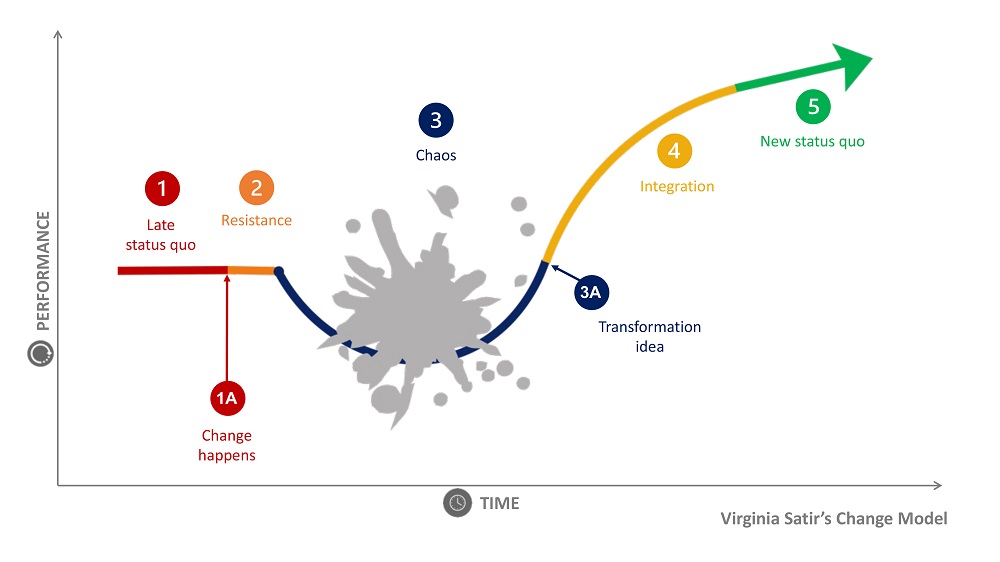Change can make a lot of us feel very uncomfortable. We can find ourselves lost in the midst of change, unsure how to move forwards, worried about the results and implications of doing things differently. Some people are so reluctant to change that it can cause real problems. As a coach, manager or mentor, change is something you’ll to support people with.
The family therapist Virginia Satir developed a six stage model for change, having carefully observed people and families experiencing and dealing with a broad range of changes. Let’s take a look at her Change Curve, and how it might help you support positive change with competence, compassion, strength, and wisdom.

Meet Virginia Satir – Formalising change to make it easier to handle
Virginia Satir, who died in 1988, was an influential American author and psychotherapist focusing on family therapy. Her pioneering work led to her nickname, the Mother of Family Therapy. Three years after she died her change model, The Satir Model: Family Therapy and Beyond, was published. And it scored a huge hit. Business management academics quickly identified the theory as essential in predicting, understanding, and managing employee reactions to change and transformation.
When do people tap into Satir’s Change Curve? It’s really useful when you want to understand the emotional state of employees who are involved in dramatic change. It’s handy when you want to make a plan for change. It’s a great way to turn people’s resistance to change into enthusiasm. And once things have changed, it’s a reliable way to help people from reverting back to the old ways.
About the Change Curve

So Satir’s model is a trusted way to help people understand the process of change and, by understanding it, feel a lot more positive about it. The model proposes several stages:
- The status quo
- The introduction of a new thing
- Chaos
- Integration
- Practice
- The new status quo
The status quo
The status quo is a friendly, familiar, safe place. It might not be perfect but nobody’s motivated to change. You can make reliable predictions about the immediate future. Your days will be much the same. You’ve established your working practices and they’re trundling along nicely. There’s no need to tinker.
Introducing a new thing
At some point in every organisation’s lifecycle a new thing will come along. It could be an internal change inspired by someone in the business, a change to the wider environment the company operates in, an external change in the market, or simply the discovery that an old assumption no longer fits the bill. Whatever the reason, it disrupts the status quo.
Chaos
At the chaos stage, things are pretty unpredictable. The system is operating in ways nobody can foresee. It’s uncomfortable, but this is where the change process, the transformation can potentially start.
We all react in different ways to the discomfort we feel when our security and stability disappear. Some of us can’t believe what’s happening and go into a state of denial. Others actively resist the change. Some might even try to sabotage the new plans. People can start to dread the next day, panic about what’s going to happen, feel angry and disorientated. But it doesn’t last. The transforming idea or new approach comes along, and it signals that the end of the chaos isn’t far away.
The transforming idea

A transforming idea often happens at the point where all the dread and worry is beginning to recede. One it arrives the mood begins to change to one of acceptance. The transforming idea or new approach reveals the way forward, giving people hope. The new status quo might just turn out to be better, and people start to acknowledge it.
Practice
Once the new situation is integrated into people’s minds, you can generate and implement a plan based on the transforming idea. It can take time but by this stage you’re on the right track and new working patterns will be needed. Old habits are so hard to break, everyone involved will need to knuckle down and put things into practice. At this stage, because it is new and different, time to learn, plus plenty of encouragement and feedback are crucial. If you are a manager and the person who is overseeing the change, you’ll need to lead by example and check that everything is in place to support the new approach.
The new status quo
The new way of working is integrated, everyone has practised, and it has bedded in. Now we have a fresh new status quo. This is the end of the change process. But there’ll be more changes in future, and they’ll follow the same pattern.
About us:
We create the space for leaders to step back, think clearly, and navigate complexity with confidence. By sharpening the narrative that drives decisions, teams, and performance, we help leaders move forward with clarity and impact. Our approach blends deep listening, incisive challenge, and commercial focus—strengthening leadership at every level, from business transformation to boardroom decisions.
“We share resources that help coaches deepen their practice and expand their impact. The articles on this site are designed to spark fresh thinking, offer practical tools, and support the continuous growth of coaches at every stage. “
Jude Elliman
Founder
Our Core Approach:
We work with leaders to sharpen their thinking, strengthen their leadership, and navigate complexity with confidence. Our approach is built around three core areas:
Narrative Coaching – Working with the stories that shape leadership, teams, and organisations.
Commercial Focus – Cutting through complexity to drive clear, strategic decisions.
Challenge & Space – Asking the right questions while creating the space to reflect and grow.
Through this, we help leaders drive transformation, align teams, and make high-stakes decisions with clarity and impact.
